Il Terzino
R uolo assai complesso, quello del terzino . Con il passare del tempo, e il continuo evolversi delle tattiche, è stato probabilmente il ruolo più suscettibile a cambiamenti, passando di fatto da una posizione con compiti prettamente difensivi (quasi del tutto distruttivi) ad un ruolo più complesso, quasi un misto tra ala e difensore....
 |
| I due terzini nel "Metodo". |
Con l’avvento delle prime tattiche, e soprattutto il famoso “ Metodo ”, i giocatori in campo erano ideologicamente suddivisi in tre zone. C’era la prima linea, composta dagli attaccanti, la seconda linea, costituita dai centrocampisti, e la terza linea, formata by two defenders. And it is the third line the name " backs . In English, the principle is the same: there were forward (striker), the half-back (midfielders) and and full-back (triplets).
said this: Originally the backs (full-backs) were the two (or three) players in front of the goalkeeper (in effect two plants), and had different tasks. A full-back was called "a sprint", and had to deal with heart-attack to mark the opponent, the other was called the "Position": during the 90 minutes had to "supervise" the penalty area, and had as its only task that to assist the defender in trouble, a sort of preamble to the future "free."
With the back four is revolutionizing the role of quarterback in a nearly complete. The two fullbacks, right and left (the defense to 4), the wings are wide, and are generally offensive and defensive tasks. When possession is called to mark the wingers, being held are not encouraged to push the cross sections from leaving or throwing to the attackers and creating numerical superiority in midfield. There are essentially two types of backs. The first is that of defensive backs, which, as the name implies, are essentially the stopper (markers) moved down the flanks, and are chronologically the earliest types of backs that can be seen on a field of play. They are generally defensive and offensive players and, basically, the Italian school is one that has produced more than any other great defensive backs.
 |
| Jose Nasazzi. |
If we speak of the "first" full-backs (ie, those two players positioned in front of the goalkeeper or the first variant of the method itself, which included three full-backs), then the great interpreters of this role are reduced, and probably the largest of them was the Uruguayan José Nasazzi , played by powerful physique, and endowed with great sense of the advance, among other things, a charismatic . Other great performers furono gli italiani Eraldo Monzeglio, Luigi Allemandi (campioni del mondo 1934) e, soprattutto, la straordinaria coppia Foni/Rava (campioni del mondo 1938) . Da notare anche il duo Rosetta/Caligaris , assoluti protagonisti nel quinquennio d’oro della Juventus (prima metà anni ’30).
Terzini moderni
 |
| Paolo Maldini with the national team |
One of the greatest defensive backs of all time, however, is probably Berti Vogts , dwarf German almost completely nullified the Dutch star Cruyff in the 1974 World Cup. So small in stature as tenacious, courageous and biting, is the classic player who will not budge for 90 minutes, even during the break between the first and second time. Has no major technical means, but it makes the determination, of teamwork and commitment its winning formula. Another great defensive back has been our Claudio Gentile , considered by many nothing less than just one of the best markers ever, perhaps even better from this point of view of German Vogts. Claudio has been criticized by many for his play at times excessive, almost violent and abusive, even if in fact he never passed that famous line that demarcates the player from the classic thug (well, maybe yes sometimes). Like all defenders markers is a tough player, real, who looks to the point. These qualities come together very good tactical and mental skills. The third example is probably the best. This is Paolo Maldini , widely regarded as the largest pure defender of all time. Precocious talent, extraordinarily gifted physically and tactically, is a fast player, physically strong, brave, ambidextrous, outstanding example of serious professional longevity and physical and off the field. It 's the ultimate player respected by everyone: coaches, teammates, opponents, referees. The best phase of his career is also a great push-back (offensive), but the best it gives back as defensive wall on a real band and a serious professional. Other examples of full-backs difensivi, ma anche notevoli in fase di propulsione: gli italiani Antonio Cabrini , Tarcisio Burgnich e Giuseppe Bergomi , l'olandese Ruud Krol , il tedesco Karl-Heinz Schnellinger , lo scozzese Danny McGrain , il portoghese Joao Pinto , the Belgian Eric Gerets .
 |
| The Brazilian Djalma Santos. |
Now to push backs, offensive and thinners (also called "sprint"). As the name says their job is mainly offensive: with their speed and their descents have to put constant concern in the opponent's rearguard. Must be the first on the raiders groups, able to disengage particularly in attack without ignoring the defensive. As with all creative and offensive role, the South American school literally gave birth to this kind of back in the '50s. While all the European teams were almost entirely defensive backs here Brazilians play with these "false" wings, literally creating havoc among opposing defenses. The main representatives of this role are then Brazilians, although we can also boasts an Italian name - and name - from the backs of free-flowing. What Giacinto Facchetti . Captain and flag of the great Inter, Hyacinth is a player extraordinary in any respect. Physical prodigious for the time of 188cm x 84kg (but not out of place even today), speed, physical strength, powerful and accurate shot, great sense of timing and placement in offensive sorties and right power and precision. In defense knows how to be proficient scorer and leader, as evidenced by the many games played as a pure stopper. Other extraordinary man is the quarterback of Botafogo and the Brazilian national Nilton Santos , which appears to Djalma Santos formed a deadly pair of fullbacks in the world of 1958 in Sweden. Left-back thrust, Nilton is not realistically flawless on defense, but the offensive is a master like few others. Dubbed the "Encyclopedia" because of his knowledge of the game of football is actually recycled as a wing-back: it is played fast, agile, has great technique, dribbling a dry, withering, of extraordinary vision of the game and great gifts dribbling. And 'he the real engine "engine" of Brazil in World 2, where is the left wing of his house. Last but not least, back is the teammate of Nilton Santos quoted above: Djalma Santos . Player often overlooked is actually one of the best fullbacks ever. It 's a player with an extraordinary muscle Negroid, resistant, tough, physically strong, skillful on defense and even more incredible in attack. According to many it is even more than companion Nilton Santos, especially on defense, and who saw him in the best phase of his career speaks of it as the best quarterback of all time. Other outstanding performers of the role are: the Brazilians Marcos Cafu , Carlos Alberto Torres , Roberto Carlos , Jorginho , English José Camacho , English Eddie Hapgood , Argentines Marzolino Silvio and Alberto Tarantini, Dutch Wim Suurbier, German Andreas Brehme , the Soviet Igor Netto (n reality that wing-back), the nostrani Gianluca Zambrotta and Mauro Tassotti .
Some examples of great fullbacks of the past, more than those described above:
Eddie Hapgood (England) : is the back stronger before the war. England captain and Arsenal in the 30s is a player with a prodigious technique, a bossy and ease of travel.
 |
| The German Schnellinger |
Karl-Heinz Schnellinger (Germany) : important player for amount of play and productivity, can also play as a stopper and the middle of the field without any problems. In the field driving the team: foot quite polite and such a sacrifice.
Burgnich Tarcisio (Italy) : Italians considered one of the best fullbacks ever. Rock right back, is almost unsurpassed in fas.e defensive, with great physical means and a great sense of position
Carlos Alberto Torres (Brazil) : probably a of the best right-back ever, full-back Carlos Alberto is probably ideal because it is unable to interpret the defensive (he was also stopper) that the offensive with equal skill and expertise, what Brazilian rare for a quarterback. It 's a quick player, technically strong, with a shot from distance and charisma in the field. He was a key player for both club (Santos and Fluminense) and for the national green-gold.
 |
| Virgil Maroso |
Alberto Tarantini (Argentina) : Toulouse and the Argentine left-back Argentina national horse of the year 70/80. His main weapon was given by the extraordinary determination and aggression that put in field: is the classic player who gives 110%, although not with great technique, like other great backs.
Maroso Virgilio (Italy): extraordinary Grande Torino left-back, is probably one of the best fullbacks in the Italian football school. In a primarily defensive role, for the time, looking to play Virgil is a feast for the eyes: speed, elegance, extraordinary technique, dribbling, physical strength. Lacks for nothing. After Mazzola is probably the best player of this great team.
Renzo de Vecchi (Italy): first phenomenon of our football was born as a left midfield role but is in the left-back who is consecrated. Player was a symbol of Genoa, the first power of Italian football, and column (and captain) of the Italian national pre-war. In the field he was a player with great tactical sense, excellent technique and bossy.

0 comments:
Post a Comment